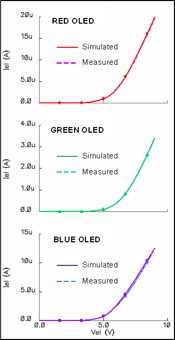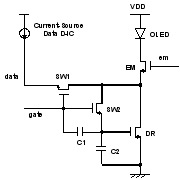
Research Archives Index
Design of a-Si:H TFT Pixel Electrode Circuits for AM-OLED
Juhn S. Yoo, Hojin Lee, and Jerzy Kanicki
 Designing pixel electrode circuits for active-matrix organic light-emitting displays (AM-OLEDs) requires accurate SPICE model of both a-Si:H TFT (hydrogenated amorphous silicon thin film transistor) and OLED (organic light emitting diode). We use RPI’s amorphous silicon TFT model for a-Si:H TFT, which features power law equation with empirical expression for leakage current. We also use Spectre Level-1 junction diode model for OLEDs, which implements two internal diodes connected in parallel for accurate fitting of the OLED current-voltage characteristics. We observed a good correlation between the measured (dotted line) and the simulated (solid line) data for our a-Si:H TFT and OLED characteristics. Designing pixel electrode circuits for active-matrix organic light-emitting displays (AM-OLEDs) requires accurate SPICE model of both a-Si:H TFT (hydrogenated amorphous silicon thin film transistor) and OLED (organic light emitting diode). We use RPI’s amorphous silicon TFT model for a-Si:H TFT, which features power law equation with empirical expression for leakage current. We also use Spectre Level-1 junction diode model for OLEDs, which implements two internal diodes connected in parallel for accurate fitting of the OLED current-voltage characteristics. We observed a good correlation between the measured (dotted line) and the simulated (solid line) data for our a-Si:H TFT and OLED characteristics.
To compensate for the OLED current variation, so that it is immune to the changes of driving TFT’s current-voltage characteristics, we introduced current driving schemes using four TFTs, two capacitors and two control signals, wherein the current signal provided by an external driver modulates the OLED current. Although the current driving scheme improves the display luminance uniformity and stability, additional time is required to charge data-line capacitive load at low data currents. Hence, we propose an improved current driven pixel circuit based on a-Si:H TFT technology with the ability to program OLED current with non-linear data-to-pixel current ratio. Circuitry of cascading capacitors is used to achieve a high data-to-pixel current ratio without increasing the TFT size. We used Spectre and HSPICE for SPICE verification of the AM-OLED pixel electrode circuits.  The proposed circuit compensates for the drive TFT’s trans-conductance variation due to non-uniformity and differential aging. The OLED current variation is less than ±10% when the threshold voltage of the drive TFT varies form 2 to 7V. The data-to-pixel current ratio at low data current is nearly 20, which reduces the data-line charging time down to 25% compared to the previous current-mirror pixel electrode circuit. This work is funded and supported by the Research and Development Center of LG. Philips LCD, Korea. The proposed circuit compensates for the drive TFT’s trans-conductance variation due to non-uniformity and differential aging. The OLED current variation is less than ±10% when the threshold voltage of the drive TFT varies form 2 to 7V. The data-to-pixel current ratio at low data current is nearly 20, which reduces the data-line charging time down to 25% compared to the previous current-mirror pixel electrode circuit. This work is funded and supported by the Research and Development Center of LG. Philips LCD, Korea.
J.S. Yoo, H. Lee, J. Kanicki, C.-D. Kim and I. -J. Chung, Journal of SID, 151-8, 545, 2007.
top
|

